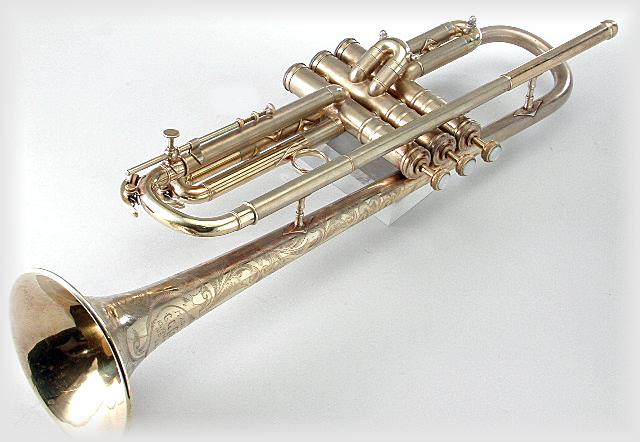Conn 22B New York Symphony "Early Model"

Date: 1924. Instrument owned by Paul Ayick.
This instrument particular is gold plated. Most Early model 22B's you will find are silver plated. The finish of an instrument (gold, silver, raw brass or lacquer) is not an indication of a particular model. It has been found that 22B's from 1924-1925 often had solid copper valve casings with brass threads soldered in. Notice the its lack of a right hand pinky ring. That isn't damage; it's supposed to be that way. Not uncommon in the 20's. Over the years the 22B evolved into the instruments listed seperately as the 22B New York Symphony "Late model" and eventually the 22B Victor. It gained a leadpipe pinky ring around 1928, and a main tuning slide brace around 1936. Instruments up to at least 1930 had top spring valves. Sometime around that date the valves became bottom spring.
The 22B New York Symphony "early model" is 19½" long, weighs 2¼ lbs and has a 4 5/8" bell. It has a #1 bore (0.438") and was built between 1922 and approximately 1935.
Don't confuse the venerable 22B New York Symphony/Victor with the current 22B Director. Entirely different class of instrument.
What Conn said in 1928-1930:
When this trumpet was first designed and manufactured it took the trumpet world off its feet. Just let one of these trumpets get
into the trumpet section of an orchestra or band and the whole section would adopt it. When soloists played it people marveled at
its pure trumpet tone. Through a constant process of refinement, this trumpet today is the most poupular in the world. Its only
rival is the New World Symphony trumpet.
The success of this superb instrument is due to the fact that it filled an urgent need. Previously the foreign trumpet had been
chosen by big artists because of its peculiarly fine trumpet tone. However, these foreign trumpets were so faulty in intonation
that users wore themselves out trying to "humor" them and "lip" them into tune. Moreover, they were extremely hard to blow. When
the New York Symphony trumpet was put on the market, possessing not only a matchless trumpet tone but also perfect intonation and
extreme ease of blowing, it is no wonder it became widely heralded practically over night.
Only the famous Conn hydraulic expansion process [described and explained on pages 8 and 9], made this fine trumpet possible.
Trumpets look pretty much alike on the outside - it's the inside surface which determines the worth of an instrument. Tone waves
are very delicate and become distorted and choked whenever the inside surface of the trumpet is wrinkled or wavy, as was true in
the foreign trumpets and is true today in inferior makes. The hydraulic expansion process insures a glassy-smooth inside surface,
the perfect surface for carrying tone waves. Only Conn trumpets are made by this process and only Conn's possess the perfect inside
surface for carrying the tone waves.
Made in a small bore, the New York Symphony trumpet has a very bright, crystal pure tone. It is brilliant without being "squealy"
or "squeaky"; it has great penetrating power without being blatant; it will play pianissimo without faltering or losing its trumpet
color; it will play fortissimo without cracking or becoming harsh; it responds with the slightest breath and can be played vigorously
all evening without exhaustion. The unparalleled favorite in theater orchestras, dance orchestras, the smaller symphonies and concert
bands, and for solo playing